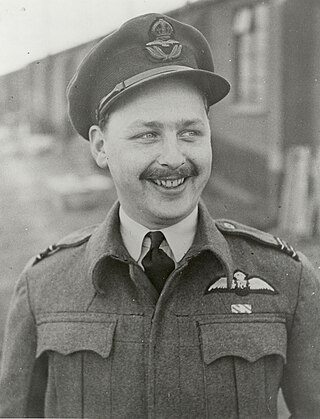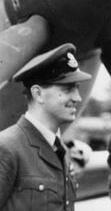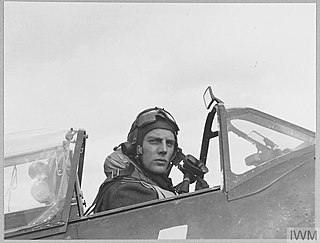
James Joseph "Orange" O'Meara, was a Royal Air Force officer and fighter pilot of the Second World War. He became a flying ace during the Battle of Britain while flying the Supermarine Spitfire, and by war's end was credited with 11 kills, two shared victories, one unconfirmed destroyed, four probables, 11 damaged and one shared damaged.

Air Commodore Alan Christopher Deere, was a New Zealand fighter ace with the Royal Air Force (RAF) during the Second World War. He was also known for several near-death experiences over the course of the war. This led to his published autobiography being titled Nine Lives.

George Cecil Unwin, was an officer in the Royal Air Force (RAF) and a flying ace of the Second World War. He is credited with destroying at least 15 German aircraft.

Group Captain Colin Falkland Gray, was a Royal Air Force (RAF) officer and the top New Zealand fighter ace of the Second World War. He was credited with at least 27 aerial victories.

Eric Stanley Lock, was a British Royal Air Force (RAF) fighter pilot and flying ace of the Second World War.

Brian Carbury, was a New Zealand fighter ace of the Royal Air Force (RAF) during the Second World War. He was officially credited with destroying 15+1⁄2 German aircraft.

John Connell Freeborn, was a fighter pilot and flying ace in the Royal Air Force (RAF) during the Second World War.

John Colin Mungo-Park, was a Royal Air Force fighter pilot and flying ace of the Second World War. He was awarded the Distinguished Flying Cross in 1940, and a Bar to the medal in 1941.

Brian John Edward "Sandy" Lane was a fighter pilot and flying ace of the Royal Air Force (RAF) during the Second World War. He also wrote the book Spitfire!, an account of his experiences as a fighter pilot during the Battle of Britain.

Anthony Lovell, was a fighter pilot and flying ace of the Royal Air Force (RAF) during the Second World War. He is credited with the destruction of at least 22 aircraft.
William Henry Franklin, DFM and Bar also known as Bill Franklin was a Royal Air Force fighter pilot and a notable Second World War flying ace decorated for gallantry twice, he shot down more than 13 enemy aircraft over the Dunkirk evacuation beaches and during the Battle of Britain before being killed in action.

John Noble MacKenzie, was a New Zealand flying ace of the Royal Air Force (RAF) during the Second World War. He was officially credited with the destruction of nine enemy aircraft.
William Thomas Edward Rolls was a British flying ace of the Royal Air Force Volunteer Reserve (RAFVR) during the Second World War. He was credited with the destruction of at least 17 aircraft of the Axis powers.

George Gribble, was a British flying ace of the Royal Air Force (RAF) during the Second World War. He was officially credited with the destruction of at least six German aircraft.

John Ellis was a British flying ace of the Royal Air Force (RAF) during the Second World War. He was credited with at least 13 aerial victories.

Edward Francis John Charles, was an English-born Canadian officer and flying ace who served in the Royal Canadian Air Force (RCAF) and the Royal Air Force (RAF) during the Second World War. During his service with the RAF, he was credited with at least fifteen aerial victories.

James Leathart, was a British flying ace who served with the Royal Air Force (RAF) during the Second World War. He was credited with having shot down at least eight aircraft.

Desmond McMullen, was a British flying ace who served with the Royal Air Force (RAF) during the Second World War. He was credited with having shot down at least twenty-two aircraft.

John Webster, was a British flying ace who served with the Royal Air Force (RAF) during the Second World War. He was credited with having shot down at least eleven aircraft.

Wilfred Sizer, was a British flying ace who served in the Royal Air Force (RAF) during the Second World War. He is credited with having shot down twelve aircraft.



















